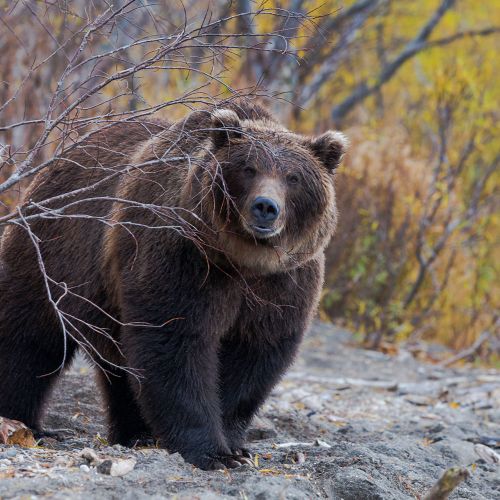Brown Bear (Asia)
Scientific Name: Ursus arctos
Subspecies: A total of 10 subspecies have been described, eight of which live in this region: 1. European-Siberian Brown Bear (Ursus a. arctos): Western Siberia (and Europe). 2. East Siberian Brown Bear (Ursus. a. yenisensis): Eastern Siberia, from Jenissei to Transbaikalia and east to the Stanowoj mountains. From the Lena- and Kolyma-basin to Jakutia, including the Altai and northern Mongolia. 3. Caucasian Brown Bear (Ursus a. meridionalis): The Caucasus, south to northern Armenia. 4. Syrian Brown Bear (Ursus a. syriacus): Syria, Lebanon, Israel, Turkey,Iran, western Himalaya, the Pamirs, the Altai and Tienshan, Azerbaijan, Turkmeniya, Iraq and Afghanistan. 5. Kashmir or Tienshan Brown Bear (Ursus a. isabellinus): Kashmir, the Pamirs and Altai mountains, Tienshan, Afghanistan, northern Pakistan to Nepal. 6. Kamchatka Brown Bear (Ursus a. piscator): Kamchatka, northern Kuril Island, the Karaginska Islands, coastal area of the Ochotski Sea, south to the Stanowoj mountains and the Shantar Islands. Outside Russia: The Lawrence Islands. 7. Ussuri Brown Bear (Ursus a. lasiotus): The Ussuri region, Sachalin, Priamurje and north to the Shantar Islands, the Stanowoj mountains, southern Kuril Islands, north-eastern Heilongjiang (Manchuria), Korea and Hokkaido (Japan). 8. Tibet Brown Bear (Ursus a. pruniosus): Northwest China (Kansu), northern Sichuan, Xizang (Tibet), Mongolia, south from Endrengiyn Nuruu and Shan in the eastern Himalaya.
Habitat: All types of forests and woodlands, but also tundra in the northern areas of
Description: Size varies from subspecies to subspecies. The Syrian Brown Bear being the smallest and the Kamschatka Brown Bear the largest. The latter reaches a weight of 600 kg and measures up to 1,45 cm over the shoulder. It reaches a total body lenght of 2,70 m and when on its hind legs almost 3 meters. The coat varies from yellowish to dark brown, often with silver- tipped hairs. In general it may be said that the Brown Bears living along coasts are larger than their relations living in mountainous regions or on plains, due to the larger percentage of fish (salmon) in their diet.
Hunting method: Stalking (spring hunts for coastal bears), on a kill, driving in winter, autumn hunts near oatfields.
Hunting available in: Almost all areas of distribution.









